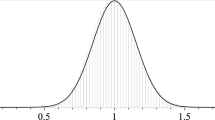Abstract
An efficient method for computing a given number of leading eigenvalues (i.e., having largest real parts) and the corresponding eigenvectors of a large asymmetric matrixM is presented. The method consists of three main steps. The first is a filtering process in which the equationx = Mx is solved for an arbitrary initial conditionx(0) yielding:x(t)=e Mt x(0). The second step is the construction of (n+1) linearly independent vectorsv m =M m x, 0⩽m⩽n orv m =e mMt x (τ being a “short” time interval). By construction, the vectorsv m are combinations of only a small number of leading eigenvectors ofM. The third step consists of an analysis of the vectors {v m } that yields the eigenvalues and eigenvectors. The proposed method has been successfully tested on several systems. Here we present results pertaining to the Orr-Sommerfeld equation. The method should be useful for many computations in which present methods are too slow or necessitate excessive memory. In particular, we believe it is well suited for hydrodynamic and mechanical stability investigations.
Similar content being viewed by others
References
Arnoldi, W. E. (1951).Q. Appl. Math. 9, 17.
Bennetin, G., Galgani, L., Giorgilli, A., and Strelcyn, J. M. (1980).Meccanica 15(9), 21.
Drazin, P. G., and Reid, W. H. (1981).The Theory of Hydrodynamic Stability, Cambridge University Press, New York.
Goldhirsch, I., Sulem, P. L., and Orszag, S. A. (1987). Stability and Lyapunov stability of dynamical systems: A differential approach and a numerical method,Physica D (in press).
Jenning, A., and Stewart, J. (1975).J. Inst. Math. Appl. 15, 351.
Lewis, J. G. (1977). Algorithms for sparse matrix eigenvalue problems, Ph.D. thesis, Stanford University report No. 77-595.
Orszag, S. A. (1971).J. Fluid Mech. 50, 689–703.
Parlett, B. N. (1980).The Symmetric Eigenvalue Problem, Prentice-Hall, Englewood Cliffs, New Jersey.
Saad, Y. (1980).Linear algebra and its applications 34, 269 (and references therein).
Shimada, I., and Nagashima, T. (1979).Prog. Theor. Phys. 61, 1605.
Stanley, H. E. (1971).Introduction to Phase-Transition and Critical Phenomena, Oxford University Press, New York.
Wilkinson, J. H. (1965).The Algebraic Eigenvalue Problem, Clarendon, Oxford University Press.
Author information
Authors and Affiliations
Rights and permissions
About this article
Cite this article
Goldhirsch, L., Orszag, S.A. & Maulik, B.K. An efficient method for computing leading eigenvalues and eigenvectors of large asymmetric matrices. J Sci Comput 2, 33–58 (1987). https://doi.org/10.1007/BF01061511
Received:
Issue Date:
DOI: https://doi.org/10.1007/BF01061511




